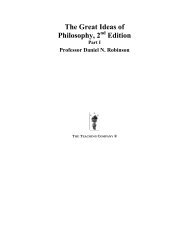English idioms in the first language and second language lexicon: a ...
English idioms in the first language and second language lexicon: a ...
English idioms in the first language and second language lexicon: a ...
Create successful ePaper yourself
Turn your PDF publications into a flip-book with our unique Google optimized e-Paper software.
348 <strong>English</strong> <strong>idioms</strong> <strong>in</strong> <strong>the</strong> L1 <strong>and</strong> L2 <strong>lexicon</strong>specifies <strong>the</strong> conditions under which conceptual representationshave to be activated. It predicts that <strong>the</strong>re is no need to activate<strong>the</strong> conceptual level if an idiom entry exists at <strong>the</strong> lexical level. Alexical entry provides all <strong>the</strong> <strong>in</strong>formation necessary to process <strong>the</strong>idiom. Conceptual knowledge has to be activated only if <strong>the</strong>re isno idiom entry at <strong>the</strong> lexical level. Then <strong>the</strong> constituent entries of<strong>the</strong> idiom activate <strong>the</strong> concepts l<strong>in</strong>ked with <strong>the</strong>m. The higherfamiliarity score for decomposable <strong>idioms</strong> seems to <strong>in</strong>dicate thisease of connection with conceptual representations. The partialcompositional nature of decomposable <strong>idioms</strong> might create a closersemantic <strong>and</strong> conceptual connection between <strong>the</strong> <strong>in</strong>dividualconstituents <strong>and</strong> <strong>the</strong> idiomatic mean<strong>in</strong>g of decomposable <strong>idioms</strong>,which probably contributes to <strong>the</strong>ir familiarity. However, notenough is known yet about <strong>the</strong> parallel activation of idiom entries<strong>and</strong> conceptual representations. Future research is needed here. 9The <strong>first</strong> three assumptions are <strong>the</strong> ma<strong>in</strong> claims made by <strong>the</strong> DIRModel, <strong>and</strong> <strong>the</strong>y refer <strong>in</strong> a general way to <strong>the</strong> lexical <strong>and</strong> <strong>the</strong>conceptual level. The comparison of native <strong>and</strong> nonnativejudgements has <strong>in</strong>dicated differences <strong>in</strong> <strong>the</strong> organization of <strong>the</strong> L1<strong>and</strong> L2 <strong>lexicon</strong>. The underly<strong>in</strong>g assumption is that speakers’judgements about <strong>the</strong> decomposability of <strong>idioms</strong> reflect <strong>the</strong>different underly<strong>in</strong>g representations <strong>in</strong> <strong>the</strong> native <strong>and</strong> <strong>the</strong> nonnative<strong>lexicon</strong>.4 Differences between <strong>the</strong> L1 <strong>and</strong> L2 <strong>lexicon</strong>Fourth assumption: Nonnative speakers do not develop as manyidiom entries as native speakers, because <strong>the</strong> frequency with whichnonnatives encounter <strong>idioms</strong> is lower. Therefore, <strong>the</strong>y more oftenhave to rely on <strong>the</strong> constituent entries <strong>and</strong> <strong>the</strong>ir correspond<strong>in</strong>gconceptual representations dur<strong>in</strong>g idiom process<strong>in</strong>g.Naturally, <strong>the</strong> fourth assumption is not <strong>in</strong>dependent of <strong>the</strong> <strong>second</strong>one. However, it seems important to state it as a separate po<strong>in</strong>t,thus stress<strong>in</strong>g that <strong>the</strong> differences between native <strong>and</strong> nonnativerepresentations are not always due to <strong>in</strong>ter<strong>language</strong> problems, butare also determ<strong>in</strong>ed by o<strong>the</strong>r, more general factors such asfrequency. As research on <strong>the</strong> L1 <strong>and</strong> L2 <strong>lexicon</strong> has shown, <strong>the</strong>yare qualitatively similar <strong>in</strong> nature (e.g., S<strong>in</strong>gleton, 1993; 1994; 1996a;9The assumption that nonnatives necessarily rely more on conceptual representations is <strong>in</strong>accordance with results from neurol<strong>in</strong>guistic studies, which have shown that bil<strong>in</strong>guals showgreater right-hemisphere participation than monol<strong>in</strong>guals (e.g., Paradis, 1998a). In particular,<strong>the</strong>se studies show that <strong>the</strong> conceptual aspects of <strong>idioms</strong> are related to pragmaticcompetence, which is located <strong>in</strong> <strong>the</strong> right hemisphere (Paradis, 1998b).Downloaded from http://slr.sagepub.com at Shanghai Jiaotong University on March 7, 2009














